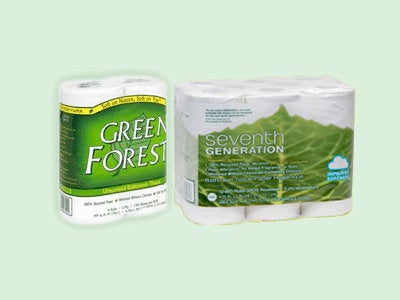
 Tough times demand tough decisions, and perhaps, rough toilet paper. The New York Times' Leslie Kaufman says the soft puffy Charmin stuff many of us are addicted to is bad for forests. From recycled paper fibers you can only make the rougher toilet paper, which means ever more trees (including some old-growth Canadian forests) are being cut to -- softly -- wipe our butts.
Tough times demand tough decisions, and perhaps, rough toilet paper. The New York Times' Leslie Kaufman says the soft puffy Charmin stuff many of us are addicted to is bad for forests. From recycled paper fibers you can only make the rougher toilet paper, which means ever more trees (including some old-growth Canadian forests) are being cut to -- softly -- wipe our butts.
Is this stupid? Yes.
"No forest of any kind should be used to make toilet paper," Dr. Allen Hershkowitz, a senior scientist and waste expert with the Natural Resource Defense Council, told the NYT.
Hershkowitz is right. However, do we have the time to convince everyone? More than ever, giving people a bad news message - Charmin and clear-cutting, or rough and recycled, take your pick - leaves many of us cranky and disgruntled. Give up chocolate for Lent, okay, that's part of my cultural traditions. Give up soft t.p. for trees? Nope. No can do.
Finnish-British documentary filmmaker John Webster in his film "Recipes for Disaster" questions the whole Western ideal around toilet paper. In one of the film's most comical scenes Webster's wife anxiously scours the city of Helsinki looking for toilet paper after the family self-imposes a plastic wrapper ban, and she is incredibly jubilant upon locating huge industrial rolls of toilet paper not swathed in a plastic wrapper. (Clip below includes her happily bringing home the loot.)
But why, Webster asks, do we entrust this soiled area of our anatomy to squares of dry paper (be it the rough or pillowy soft kind) anyway? Isn't that a little, well, unhygienic? Couldn't we shift to those Japanese toilets with the bidet and drying element built in?
Shouldn't we take a hint from Islamic culture and ask ourselves, "If there's **it anywhere on our body would we prefer to wipe it away with paper or wash it off with water?"
Yet somewhere between 1871, when Zeth Wheeler introduced the first rolls of perforated paper for bathroom use, and today, we've decided fluffy white squares and a white porcelain throne are the only way to go.
So what do we do? Do we, like toilet tissue manufacturer Marcal, spend $30 million on a campaign to convince Americans to buy more recycled content in their toilet paper.
Yes, with a caveat. Instead of waiting decades for carbon-soaking forests to stop being decimated by our need for t.p., this is an area where the government should step in. Someone needs to step up and tell us that next year or in two years or three, all toilet tissue will be 20 percent recycled fibers (for example).
Yes, Kimberly-Clark will scream and cry, and yes, it seems like a somewhat trivial matter. Yet enforced cultural change is hard. We keep buying the soft stuff that strips the forests because it's there on the shelf. So this might not be the place where we can afford to wait for every last human consumer to decide that recycled t.p. is okay. We need the forests and their CO2 absorption now.
So instead of letting demand drive forest decimation, let's get Euro and demand manufacturers put increasing amounts of recycled fiber into their squares. If we did I'll just bet they'll find another technique to eventually give us soft and recycled. In the meantime we all suffer the relative indignity of the new rough and tough toilet paper era together.
Read more on t.p. at TreeHugger
::Update on No Impact Man: The Year Without Toilet Paper
::Bidets: Eliminate Toilet Paper, Increase Your Hygiene
::How to Shop Smart, Save Forests and Send a Message
::High-Tech Bidets Save Paper and Your Health
::Green Your Toilet Paper: Over is Better!
::TreeHugger Tips: Hacking a Composting Toilet